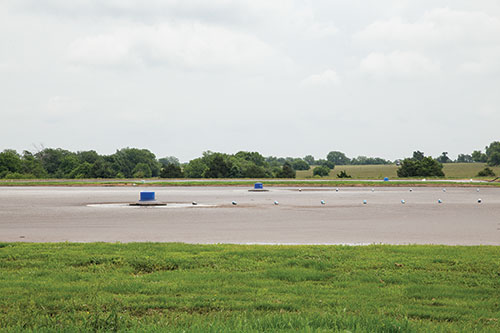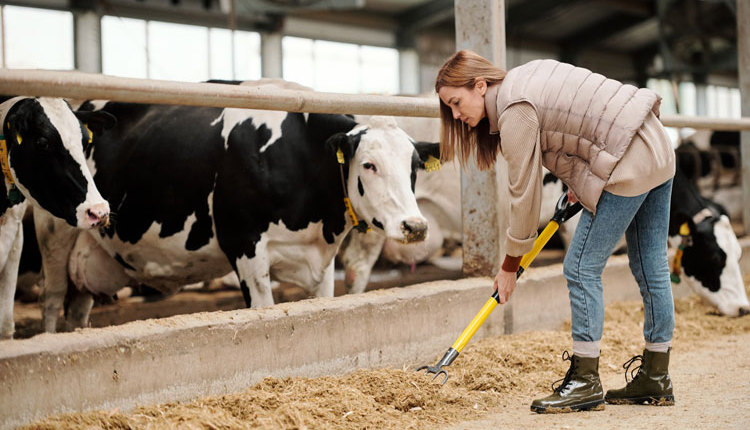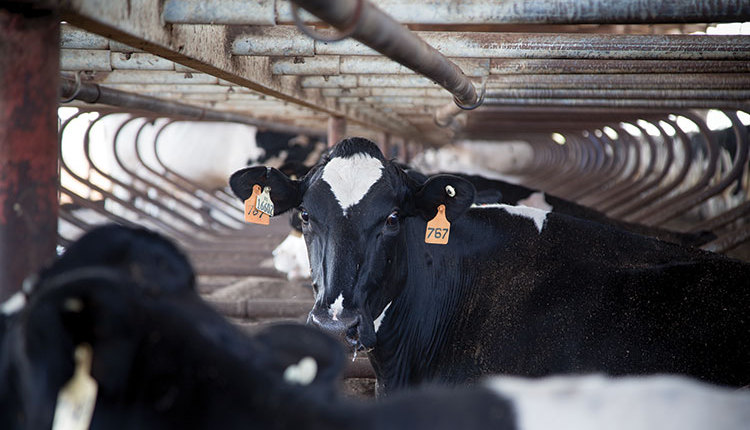The authors are field specialists with Iowa State Extension and Outreach. Funding for the project was provided by a USDA-RME Grant.

Manure is a valuable resource, but storing and handling it comes with a cost. Producers are encouraged to calculate their manure costs per hundredweight of milk.
Manure is anything but waste. It is a valuable resource, but it costs something to get it from the cows to your crops. Producers seldom determine their costs of handling and applying manure on a per hundredweight (cwt.) of milk sold basis, but they probably should.
Members of the Iowa State University Extension and Outreach team (including Jennifer Bentley, Greg Brenneman, Kris Kohl, Ron Lenth, Kristen Schulte, Leo Timms and Larry Tranel) surveyed 22 dairy producers in eastern Iowa to compile data and help people understand their cost for handling, storing and applying manure. The survey included both tie stall and freestall barns with sand, dried manure solids, mattresses or waterbeds in the stalls. The sand farms were classified as either a single or two-stage manure system.
As you can see, a wide range of systems were part of this study. The whole of the data was averaged overall, but it was also compiled into the five separate groups named above but with the mattress and waterbed farms combined into one.
From cow to storage
The average farm in the study milked 188 cows with an annual production per cow of 23,578 pounds. The farms produced and applied 7,000 gallons of liquid manure per cow and 10.4 tons of solid manure per cow.
The cost of handling manure was broken into two groups. The first group of costs were those incurred in handling manure from the time the cow dropped it until the time the manure was in storage. The second group were those costs incurred getting the manure from storage and applied in the field.
For group one costs, the average farm had $364.79 invested in manure storage per cow and $147.45 in storage and handling equipment. Structure and equipment depreciation combined for a cost of $35.65 per cow with interest adding $25.61 per cow. Repairs, taxes and insurance (most farms just used common percent values) equaled $15.22 per cow, and other expenses such as fuel and supplies added another $11.89 per cow. Labor hours per cow averaged 2.18 hours or $32.13 per cow annually. So, the total annual group one costs for getting the manure into storage was $120.50 per cow or 53 cents per cwt.
From storage to the field
Group two included those costs associated with getting the manure from storage to application. This phase had equipment values of $452.67 per cow. Depreciation of this investment value equated to $64.67 per cow with interest adding another $22.63 per cow. Repairs, taxes and insurance combined were $15.84 per cow. Other expenses added $16.11.
Labor hours averaged 1.85 per cow or $27.30 per cow annually. Custom handling costs added another $39.08 per cow. So, the total group costs for getting the manure from storage to application was $185.63 per cow or 80 cents per cwt.
Almost all of the farms surveyed soil tested their fields at least once every four years for nutrient needs. The manure nutrient levels applied to the field were determined in a few ways; personal judgment (33 percent), annual results sent to a testing lab (33 percent) and standard manure nutrient book values (14 percent), or used assistance from the local agronomist or consultant to determine values (19 percent).
Ten producers had a Nutrient Management Plan or NMP. Common nutrients producers used to determine crop fertilizer requirements included nitrogen, phosphorus, potassium, with a few using sulfur and micronutrients. Some used additives such as phosphate, boron and/or manganese.
All respondents felt there was some value of the manure applied to their crop ground. Half of those surveyed have worked with the NRCS and their EQUIP program, including assistance with construction of a manure pit, settling basin, filtered grass strips and a few with pasture renovation for grazing.
Over half of the respondents commented they would like to add more capacity to their manure storage. Other changes included updating the manure transfer method from housing to storage, upgrading the current manure system and adding solids or sand settling/removal capability.
Know your own numbers
The cost of storing, hauling and applying manure averaged $306.13 per cow or $1.33 per cwt. If we subtract the nutrient value of the manure applied (using book values and assuming perfect utilization), the net cost of storing, hauling and applying manure averaged $104.10 per cow or 45 cents per cwt.
The tie stall barns had a cumulative cost per cwt. of $1.42; the mattress/waterbed barns, $1.50 per cwt.; the two-stage sand systems, 97 cents per cwt.; the one-stage sand systems, $1.44 per cwt.; and the dried manure solid barns had a cumulative cost per cwt. of $1.24.
When the 22 farms are broken down into five groups based on type of manure storage or handling system, the representative sample in each group is too small to fairly compare one system to another. Keeping this risk of error in mind, in our study it was the manure solids group that had the lowest costs. We only used costs for getting manure to the separator, as separator costs were attached to the bedding system costs. This may or may not be an unfair advantage. The two dried manure solids systems in our study had an average cost of $242.39 per cow before nutrient value was considered. The cost of the two-stage sand system was similar at $257.01. The other systems all cost more than $300 per cow.
As producers consider using this data to make decisions, also realize the wide range of costs even within each system type. For instance, when considering the net cost minus nutrient value per cow in the one-stage sand systems, the range was -$101.02 to $296.94, a $397.96 difference in per-cow costs.
What we can take away from this is there are many significant costs incurred in storing, handling and applying this valuable by-product. Producers are encouraged to understand their manure handling costs and how it affects their costs of production.
Click here to return to the Crops & Forages E-Sources
1507_452

Manure is anything but waste. It is a valuable resource, but it costs something to get it from the cows to your crops. Producers seldom determine their costs of handling and applying manure on a per hundredweight (cwt.) of milk sold basis, but they probably should.
Members of the Iowa State University Extension and Outreach team (including Jennifer Bentley, Greg Brenneman, Kris Kohl, Ron Lenth, Kristen Schulte, Leo Timms and Larry Tranel) surveyed 22 dairy producers in eastern Iowa to compile data and help people understand their cost for handling, storing and applying manure. The survey included both tie stall and freestall barns with sand, dried manure solids, mattresses or waterbeds in the stalls. The sand farms were classified as either a single or two-stage manure system.
As you can see, a wide range of systems were part of this study. The whole of the data was averaged overall, but it was also compiled into the five separate groups named above but with the mattress and waterbed farms combined into one.
From cow to storage
The average farm in the study milked 188 cows with an annual production per cow of 23,578 pounds. The farms produced and applied 7,000 gallons of liquid manure per cow and 10.4 tons of solid manure per cow.
The cost of handling manure was broken into two groups. The first group of costs were those incurred in handling manure from the time the cow dropped it until the time the manure was in storage. The second group were those costs incurred getting the manure from storage and applied in the field.
For group one costs, the average farm had $364.79 invested in manure storage per cow and $147.45 in storage and handling equipment. Structure and equipment depreciation combined for a cost of $35.65 per cow with interest adding $25.61 per cow. Repairs, taxes and insurance (most farms just used common percent values) equaled $15.22 per cow, and other expenses such as fuel and supplies added another $11.89 per cow. Labor hours per cow averaged 2.18 hours or $32.13 per cow annually. So, the total annual group one costs for getting the manure into storage was $120.50 per cow or 53 cents per cwt.
From storage to the field
Group two included those costs associated with getting the manure from storage to application. This phase had equipment values of $452.67 per cow. Depreciation of this investment value equated to $64.67 per cow with interest adding another $22.63 per cow. Repairs, taxes and insurance combined were $15.84 per cow. Other expenses added $16.11.
Labor hours averaged 1.85 per cow or $27.30 per cow annually. Custom handling costs added another $39.08 per cow. So, the total group costs for getting the manure from storage to application was $185.63 per cow or 80 cents per cwt.
Almost all of the farms surveyed soil tested their fields at least once every four years for nutrient needs. The manure nutrient levels applied to the field were determined in a few ways; personal judgment (33 percent), annual results sent to a testing lab (33 percent) and standard manure nutrient book values (14 percent), or used assistance from the local agronomist or consultant to determine values (19 percent).
Ten producers had a Nutrient Management Plan or NMP. Common nutrients producers used to determine crop fertilizer requirements included nitrogen, phosphorus, potassium, with a few using sulfur and micronutrients. Some used additives such as phosphate, boron and/or manganese.
All respondents felt there was some value of the manure applied to their crop ground. Half of those surveyed have worked with the NRCS and their EQUIP program, including assistance with construction of a manure pit, settling basin, filtered grass strips and a few with pasture renovation for grazing.
Over half of the respondents commented they would like to add more capacity to their manure storage. Other changes included updating the manure transfer method from housing to storage, upgrading the current manure system and adding solids or sand settling/removal capability.
Know your own numbers
The cost of storing, hauling and applying manure averaged $306.13 per cow or $1.33 per cwt. If we subtract the nutrient value of the manure applied (using book values and assuming perfect utilization), the net cost of storing, hauling and applying manure averaged $104.10 per cow or 45 cents per cwt.
The tie stall barns had a cumulative cost per cwt. of $1.42; the mattress/waterbed barns, $1.50 per cwt.; the two-stage sand systems, 97 cents per cwt.; the one-stage sand systems, $1.44 per cwt.; and the dried manure solid barns had a cumulative cost per cwt. of $1.24.
When the 22 farms are broken down into five groups based on type of manure storage or handling system, the representative sample in each group is too small to fairly compare one system to another. Keeping this risk of error in mind, in our study it was the manure solids group that had the lowest costs. We only used costs for getting manure to the separator, as separator costs were attached to the bedding system costs. This may or may not be an unfair advantage. The two dried manure solids systems in our study had an average cost of $242.39 per cow before nutrient value was considered. The cost of the two-stage sand system was similar at $257.01. The other systems all cost more than $300 per cow.
As producers consider using this data to make decisions, also realize the wide range of costs even within each system type. For instance, when considering the net cost minus nutrient value per cow in the one-stage sand systems, the range was -$101.02 to $296.94, a $397.96 difference in per-cow costs.
What we can take away from this is there are many significant costs incurred in storing, handling and applying this valuable by-product. Producers are encouraged to understand their manure handling costs and how it affects their costs of production.
1507_452










